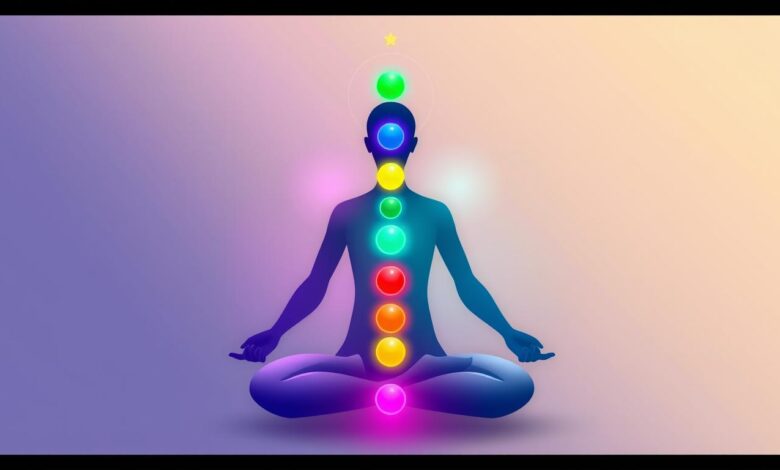
Yoga Nidra for Stress Relief: Unlock Deeper Relaxation
In a world where stress feels constant, yoga nidra for stress relief offers a proven solution. This ancient practice, often called “yogic sleep,” combines guided meditation with deep relaxation practices to calm the mind and body. Unlike ordinary relaxation, yoga nidra accesses a state between wakefulness and sleep, targeting stress at its roots.
Rooted in centuries-old traditions, yoga nidra uses systematic body scans and breath awareness to quiet the nervous system. Modern studies show it lowers cortisol, the stress hormone, making it ideal for today’s fast-paced lifestyles. Unlike sitting meditation, it guides practitioners into a conscious state of rest where tension dissolves naturally.
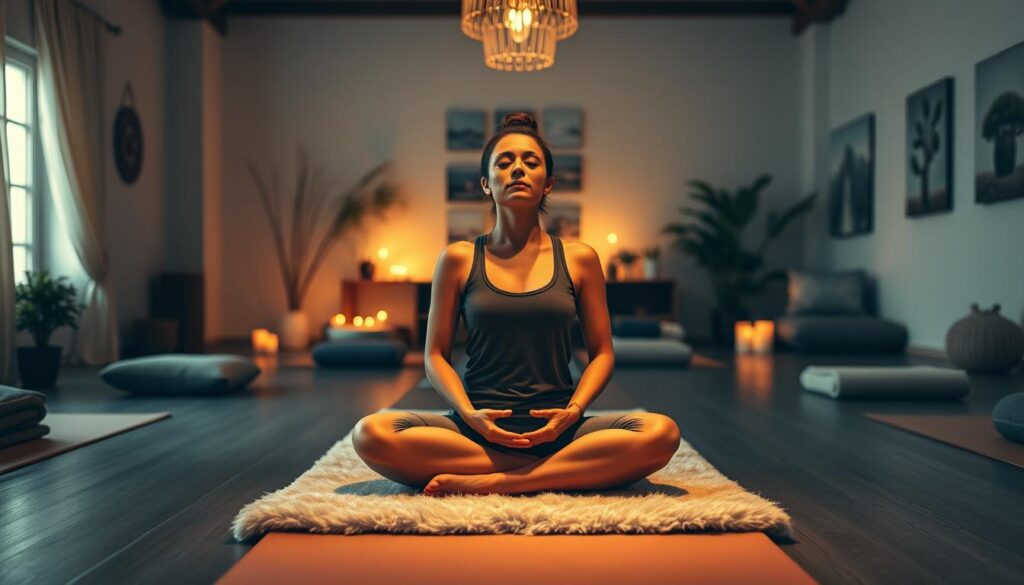
Developed from classical yoga texts, this method has evolved into accessible sessions that anyone can try. By focusing on body sensations and breath, yoga nidra helps release stored stress without requiring years of practice. It’s a tool for anyone seeking relief from anxiety, better sleep, or emotional balance.
Key Takeaways
- Yoga nidra uses guided techniques to reduce stress through conscious relaxation.
- It balances modern stressors by activating the body’s natural relaxation response.
- Originating from ancient practices, it’s now a science-backed method for mental well-being.
- Focuses on breath and body awareness to lower cortisol levels effectively.
- Accessible for all skill levels, offering deeper rest than typical meditation.
What is Yoga Nidra and How Does It Work?
Yoga Nidra is a guided meditation practice designed to induce profound relaxation. Unlike traditional sleep, it keeps participants in a conscious state halfway between waking and sleep. This technique uses verbal guidance to direct awareness, helping the body release tension.
Understanding the Basics of Yoga Nidra
At its core, yoga nidra follows a structured sequence. Participants lie in a comfortable position while a guide leads them through steps like body scanning, breath focus, and visualization. Key elements include:
- Body scans to identify tension points
- Intention-setting to align mental focus
- Guided imagery to shift thought patterns
The Science Behind Deep Relaxation
Research shows yoga nidra triggers measurable changes in the body. A 2020 study in the Journal of Bodywork and Movement Therapies found practitioners experienced a 30% drop in cortisol levels after sessions. Here’s how it works:
| Body Response | Effect |
|---|---|
| Parasympathetic nervous system activation | Slows heart rate |
| Theta wave production | Enhances mental calmness |
| Cortisol reduction | Lowers stress hormone levels |
“Yoga nidra doesn’t just feel relaxing—it reprograms the body’s stress responses,” says Dr. Sarah Lee, a neuroscientist at Stanford University.
These mechanisms make it a powerful tool for those seeking sustainable relaxation techniques for stress. By combining ancient wisdom with modern neuroscience, it offers a proven path to holistic wellness.
Benefits of Yoga Nidra for Stress Relief
Yoga nidra isn’t just a practice—it’s a science-backed tool for transforming daily stress. Let’s explore three key ways it supports mental and physical health.

Reducing Anxiety and Tension
Stress reduction through yoga nidra starts by calming the body’s fight-or-flight response. During sessions, heart rate and muscle tension drop, easing symptoms of yoga nidra for anxiety. Many users report feeling lighter mentally after just one session.
- Activates parasympathetic nervous system
- Lowers cortisol, the “stress hormone”
- Reduces panic attack frequency over time
Improving Sleep Quality
Yoga nidra’s guided relaxation addresses sleep disruptions caused by stress. Practitioners often notice:
| Before Yoga Nidra | After Regular Practice |
|---|---|
| Difficulty falling asleep | Fall asleep 30% faster |
| Nighttime anxiety spikes | 40% fewer middle-of-the-night wake-ups |
“Yoga nidra reprograms the brain to let go of tension, even during rest.”
Enhancing Emotional Well-Being
Regular practice builds emotional resilience. Participants often report:
• Greater awareness of stress triggers
• Fewer emotional overreactions
• Improved mood stability
These changes come from increased self-awareness and the practice’s focus on mental stillness.
How to Prepare for a Yoga Nidra Session
Getting ready for yoga nidra starts with small steps that boost your practice’s impact. These tips help you create the perfect environment and schedule to make the most of yoga nidra techniques and mindfulness for stress relief.
Creating a Comfortable Space
Set up your space to promote ease and focus:
- Choose a quiet area free from noise or interruptions.
- Lay a yoga mat or towel on the floor. Add cushions or folded blankets under knees or spine for support.
- Use an eye pillow to block light and deepen relaxation.
- Adjust room temperature to stay warm but not too hot.
Choosing the Right Time
Timing matters. Try these guidelines:
- Practice in the morning to start the day calmly.
- Evenings work well to unwind before bed, aiding sleep and stress relief.
- Avoid rush hours—aim for 20–30 minute blocks when you’re free from tasks.
- Keep sessions short at first if you’re new, then extend as you grow comfortable.
Experiment to find what fits your routine. Consistency matters more than perfection!
The Role of Breath in Yoga Nidra
Mastering your breath is key to unlocking the full potential of yoga nidra. Proper breathing techniques calm the mind and prime the body for deep relaxation, making them essential relaxation techniques for stress.
Techniques for Conscious Breathing
Try these methods during practice:
- Diaphragmatic Breathing: Lie down and place a hand on your belly. Inhale deeply, expanding the abdomen fully before exhaling slowly.
- Extended Exhalation: Lengthen exhales to twice the inhale duration. This shifts the body from “fight or flight” to rest mode.
- Breath Counting: Silently count each inhale and exhale cycle. This mindfulness for stress relief anchors focus and reduces mental clutter.
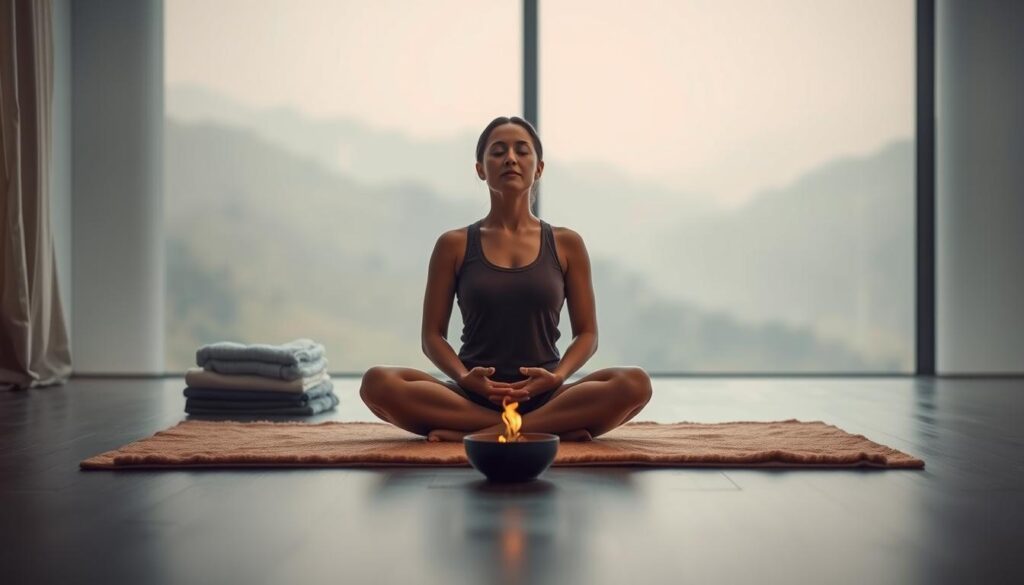
How Breath Affects Stress Levels
Science shows slow, rhythmic breathing lowers cortisol—the stress hormone. When you inhale, your heart rate speeds slightly; exhales slow it down. This balance, called respiratory sinus arrhythmia, calms the autonomic nervous system. Dr. Herbert Benson of Harvard notes this “relaxation response” counteracts stress physically and mentally.
“Breath control is the bridge between body and mind,” says yoga therapist Shanti Kirkpatrick. “It turns yoga nidra into a portable tool for daily stress management.”
By practicing these techniques, you transform breathing from automatic to intentional—building a lifelong skill to counter stress anytime, anywhere.
Essential Equipment for Effective Practice
Creating the perfect environment for yoga nidra starts with the right tools. While deep relaxation practices can be done anywhere, certain items help maximize comfort. Even without special equipment, yoga nidra techniques remain accessible to all.
Yoga Mats and Blankets
A thick yoga mat provides cushioning for your body during sessions. Look for options ½ inch or thicker to avoid discomfort. Layering blankets around your body helps maintain warmth—critical as body temperature drops during deep relaxation practices. Microfiber or wool blankets retain heat well. Can’t invest in a mat? A folded blanket works as a budget-friendly base.
Eye Pillows and Bolsters
Eye pillows made from flaxseed or rice block light and apply gentle pressure to the eyes, triggering the oculocardiac reflex to calm the nervous system. Bolsters support the spine and joints during extended relaxation. For extra comfort, consider weighted blankets or aromatherapy diffusers with calming scents. Always prioritize accessibility: household items like pillows or towels can substitute for store-bought props.
- Eye pillows: Choose breathable fabric; avoid synthetic materials.
- Bolsters: Opt for firm yet soft fills to cradle the body without strain.
- Alternatives: Rolled towels work as bolsters; use socks filled with rice as a DIY eye pillow.
Remember: Props enhance, but never replace, your focus on breath and mental stillness.
Step-by-Step Guide to Practicing Yoga Nidra
Mastering yoga nidra starts with clear steps. Follow this guide to create a consistent practice that calms the mind and reduces stress.
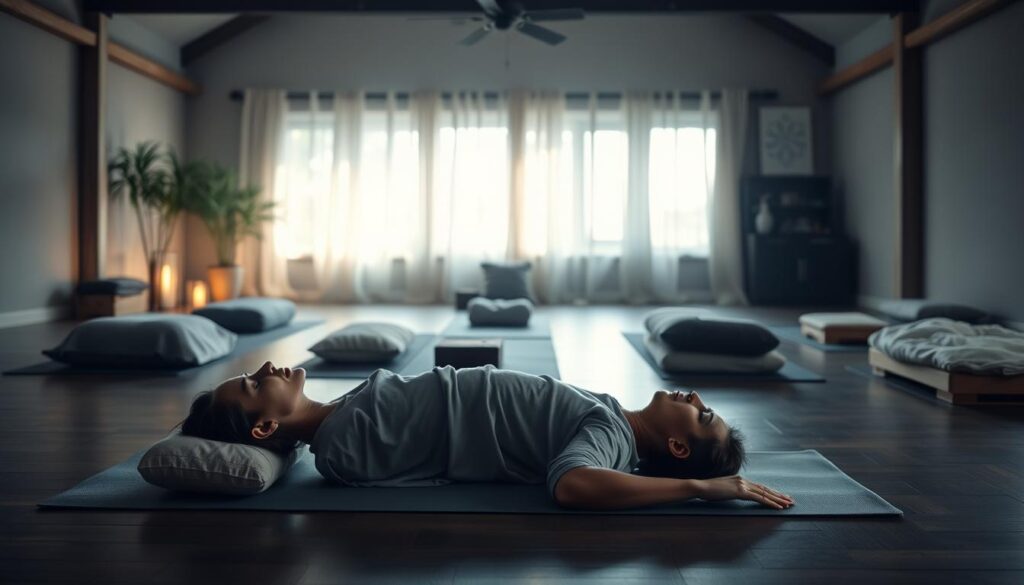
Finding a Guided Session Online
Begin by exploring trusted platforms offering guided meditation for stress relief. Popular options include:
- YouTube: Search “yoga nidra script” playlists
- Insight Timer: Filter sessions by length and teacher expertise
- Calm App: Access curated sessions for beginners
Choose sessions 15–30 minutes long with clear, soothing voices. Free trials and paid subscriptions let you explore different styles.
Key Elements of a Yoga Nidra Practice
| Phase | Description |
|---|---|
| Settling | Lie comfortably, set an intention (sankalpa) like “I release tension.” |
| Body Scan | Follow guided attention to body parts, from toes to head. |
| Visualization | Imagine calming scenes, such as a quiet beach or forest. |
| Awakening | Gradually return to awareness, noting how your body feels. |
Common challenges? If drifting asleep, try sitting upright or using a 20-minute timer. Let your mind wander—return gently to the guide’s voice.
Incorporating Yoga Nidra into Your Routine
Turning yoga nidra into a habit means aligning it with your lifestyle. Small, consistent steps create lasting stress reduction through yoga. Here’s how to make it stick.
Daily Practices for Stress Management
- Start with 10-minute sessions during lunch breaks or before bedtime.
- Set phone reminders 10 minutes before your chosen time.
- Pair practice with existing routines, like after brushing teeth at night.
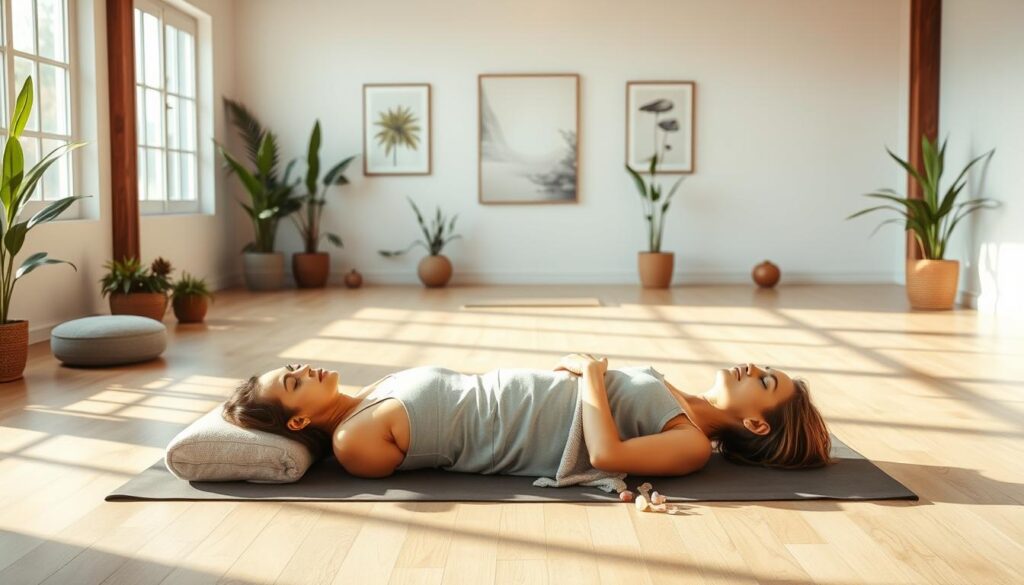
Weekly Check-ins to Monitor Progress
Track changes with these tools:
| Method | How to Use |
|---|---|
| Journaling | Note mood shifts after each session. |
| Sleep tracking | Use apps to log rest quality over weeks. |
| Self-checks | Rate stress levels 1–10 weekly. |
Adjust your schedule if mornings work better than evenings. Flexibility keeps practice alive. Celebrate small wins—like sticking to two sessions a week—to build momentum. Remember, even 10 minutes of yoga nidra for stress relief can shift your day. Progress isn’t linear, but consistency fosters resilience.
Common Misconceptions about Yoga Nidra
Many avoid yoga nidra due to myths that overshadow its yoga nidra benefits. Let’s clarify these misunderstandings to help you embrace this practice confidently.
Debunking Myths Surrounding the Practice

- Myth 1: “Yoga nidra is just napping.” Fact: It’s a structured deep relaxation practice that boosts awareness, unlike passive sleep.
- Myth 2: “You need yoga experience.” Fact: Beginners thrive—no poses or flexibility required.
- Myth 3: “It’s too spiritual.” Fact: Secular versions focus on mental health, accessible to all belief systems.
- Myth 4: “Sessions must be long.” Fact: Even 15-minute sessions deliver yoga nidra benefits.
Addressing Concerns About Sleep
“Yoga nidra doesn’t replace sleep—it enhances it,” says Dr. Sarah Lee, a sleep specialist at Mindful Wellness Institute.
Concerns about sleep often arise: Will it disrupt bedtime? Falling asleep during practice—is that okay? Here’s clarity:
- Timing: Practice anytime, but avoid late evenings if you’re sensitive to drowsiness.
- Falling asleep: It’s natural! The practice still lowers stress, even if you drift off.
- Sleep hygiene: Yoga nidra complements—not replaces—healthy sleep habits like consistent bedtimes.
By addressing these myths, you can experience the deep relaxation practices yoga nidra offers without hesitation.
Real-Life Success Stories
Yoga nidra for anxiety and guided meditation for stress relief have transformed lives in countless ways. Here are stories from people who’ve embraced these practices:

Testimonials from Practitioners
“After just two weeks of daily guided meditation for stress relief, I noticed fewer panic attacks. Yoga nidra helped me reset during my 9-to-5 grind.” — Michael, IT Manager
- Emily, a new mom: Reduced postpartum anxiety by 70% using 15-minute yoga nidra sessions.
- David, college student: Improved focus and sleep by pairing yoga nidra for anxiety with study breaks.
- Rachel, cancer survivor: Used guided meditation for stress relief to manage treatment-related stress.
The Impact of Regular Practice
A 2023 study by the International Journal of Yoga Therapy found:
| Group | Participants | Average Stress Reduction |
|---|---|---|
| Corporate workers | 120 | 45% |
| Parents | 85 | 38% |
| Students | 150 | 52% |
These results show yoga nidra’s versatility. Small, consistent sessions can build resilience over time. Progress varies, but many find lasting benefits by making it a habit. Whether you’re stressed at work or overwhelmed at home, these stories prove there’s space for calm in every life.
Additional Resources for Learning Yoga Nidra
Deepening your practice doesn’t stop here. Explore curated resources to refine your yoga nidra techniques and access guided scripts that align with your goals. Whether you prefer self-study or structured learning, these options provide pathways to mastery.
Recommended Books and Apps
Start with foundational texts like Yoga Nidra for Complete Relaxation and Deep Sleep by Richard Miller, which offers step-by-step yoga nidra scripts tailored for stress relief. For modern tools, apps like Insight Timer and Calm feature guided sessions led by certified instructors, many including customizable yoga nidra techniques for anxiety or sleep. These resources blend tradition with technology, making it easy to practice anytime.
Online Courses and Workshops
Expand your knowledge through platforms like Yoga Download and Udemy, which host courses from experts like Jennifer Reis. These programs often include downloadable scripts and methodical guides to refine techniques. For immersive learning, check workshops from organizations like the Niroga Institute, which focus on applying yoga nidra in daily life. Courses vary from free introductory modules to advanced certifications, ensuring options for all skill levels.
Every resource builds on the principles explained earlier, whether you’re adapting a script for bedtime or mastering techniques for mindfulness. Explore what resonates with your journey—your next step is just a click away.
FAQ
What is yoga nidra and how does it differ from regular meditation?
Yoga nidra, often referred to as “yogic sleep,” is a form of guided meditation that promotes deep relaxation and awareness. Unlike regular meditation, which can involve focused concentration, yoga nidra guides you into a state between wakefulness and sleep, allowing for profound physical, mental, and emotional relaxation.
Can yoga nidra help with stress relief and anxiety?
Yes, yoga nidra is particularly effective for stress relief and anxiety management. By activating the body’s relaxation response, it can significantly reduce anxiety levels and help in managing stress-related symptoms. Regular practice encourages mindfulness and promotes emotional well-being.
How do I prepare for a yoga nidra session?
To prepare for a yoga nidra session, create a comfortable and quiet space with minimal distractions. Use props like yoga mats, pillows, and blankets to enhance comfort. Choose an optimal time for practice, whether it’s in the morning, before bed, or during a midday break.
Are there specific breathing techniques used in yoga nidra?
Yes, yoga nidra incorporates various breathing techniques, such as diaphragmatic breathing and extended exhalation. These conscious breathing practices help prepare the mind and body for a deeper state of relaxation, reducing stress and enhancing the overall experience.
What equipment do I need to practice yoga nidra effectively?
While you can practice yoga nidra with minimal equipment, using a comfortable yoga mat, blankets for warmth, and an eye pillow can enhance your experience. Additional props like bolsters can be helpful for added support during practice.
How can I incorporate yoga nidra into my daily routine?
To incorporate yoga nidra into your routine, consider shorter session durations and practicing at consistent times, such as early in the morning or before bedtime. Even just 1-2 sessions a week can provide substantial benefits for stress management.
What are common misconceptions about yoga nidra?
One common misconception is that yoga nidra is simply napping. In reality, it’s a conscious practice of deep relaxation that involves awareness. Additionally, some people believe they need prior yoga experience, but yoga nidra is accessible to everyone, regardless of background.
Are there any real-life success stories from practicing yoga nidra?
Yes, there are many testimonials from individuals who have benefited from yoga nidra for stress relief. People from various backgrounds, including professionals, parents, and students, have reported significant improvements in managing stress, anxiety, and overall well-being after regular practice.
Where can I find additional resources to learn more about yoga nidra?
There are numerous resources available, including recommended books, mobile apps, and online courses focused on yoga nidra. These resources cater to all levels, offering everything from beginner introductions to advanced methodologies, allowing you to deepen your practice.

